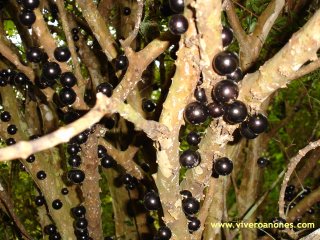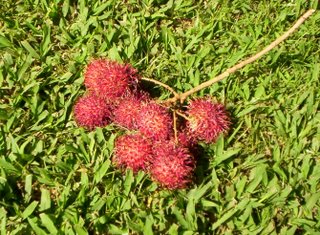Exotic Fruits I Have Known
There was only oral contact so depending upon what the definition of "known" is, it may have been in the Biblical sense, maybe not. None of them were forbidden and they where there for the ripe picking. Fragrant sticky juices were generally involved in getting to know all these fruits.
They were gone today so I had to borrow a picture, but for two weeks the Jaboticaba, Eugenia cauliflora was in full fruit. They are also known as the Brazilian Grape Tree because of their grape like flavor. It has a thick purple skin with a white gelatinous flesh with one to three small hard seeds. I just pop them in my mouth and press down firmly to release the delicious inner flesh, then discard the skin and seeds.
Photo Vivero Anones Inc.
A bit more common because they are prolific producers. Star Fruit, Averrhoa carambola has a crisp clear flesh. When fully ripe they can have a mild pear flavor. Chilled and sliced they are a nice light touch, a sorbet without all the sugar to finish off a full meal.
Here we have some baby Sapodilla, Manilkara zapota. They will double in size and elongate to become more oval shaped. This tree has a reddish pink flesh with a dense unique flavor. Chicle, the latex obtained from the bark of the tree has been used as a chewing gum base for many years.
Here is a little nest of Lilikoi, Passiflora edulis var. flavicarpa or Passion Fruit. This is a rampant vine. It will climb over and into anything it can wrap its tendrils around. When the fruit ripen they fall to the ground. They have a thick gourd like outer skin. Inside is a jelly like substance that surrounds the hundreds of small hard round seeds. You've just got to swallow the seeds to eat it fresh. It has a mild sour edge with a touch of sweet. Lilikoi Chiffon Pie, Lilikoi Sponge Cake and yummy jam are made by straining the seeds from the flavored jelly.
One of my favorites is Rambutan, Nephelium lappaceum. The fruits are very similar to its more famous cousin the Lychee. There is a single seed surrounded by a firm translucent milky flesh. You peel off the velcro skin, pop it in your mouth and let the sweet flesh with a hint of coconut melt in your mouth. The Rambutan wins out over the Lychee because it sets fruit up to three times a year and the incredibly fussy Lychee might set a good crop once a decade.
Saving the Big Boy for last. This Jack Fruit, Artocarpus heterophyllus can double in size before it is ready to pick. Inside this doughy Bread Fruit relative can be hundreds of large seeds. Each seed is covered by a thick crisp rubbery flesh that is a combination of banana and pineapple in flavor. It is a bit of work to get to them. The outer packaging is filled with a copious gummy latex that makes for a very sticky extraction process. It is well worth the effort. Jack Fuit is another one of my favorites.
All the usual suspect fruits, banana, papaya, mango, avocado, pineapple and citrus are too ordinary to be considered truly exotic.


1 comment:
The Jaboticaba reminds me of a Redbud tree in the way the flowers pop out along the trunk and branches. It doesn't sound familiar, but every once in awhile I've noticed the star fruit or the passion fruit at grocery stores, and I think lychees were there, too. My husband loves almost all fruit, from apples and oranges to mangos and papayas, and he'd be happy to try everything in this post. My idea of tropical is a pineapple or banana, unless you'd count an individually wrapped slice of Guava paste from Fiesta Market.
When you look at the odd shapes and colors of ALL fruit, edible, non-edible, and even toxic, it amazes me at how experimental the earliest people must have been, trying to find something delicious that wouldn't kill you if you ate it.
Annie at the Transplantable Rose
Post a Comment